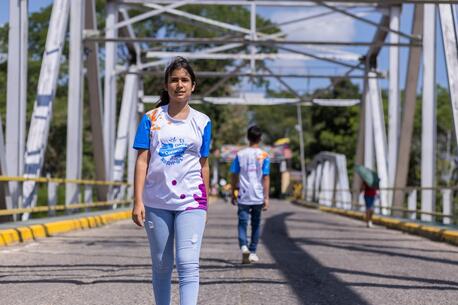It's Time to End Female Genital Mutilation
The COVID-19 pandemic is threatening decades of progress in the fight to eliminate FGM. UNICEF is working with partners to protect girls from this cruel practice once and for all.
Excruciatingly painful and internationally condemned, female genital mutilation (FGM) remains a frightening reality for girls and women around the world. At least 200 million women and girls worldwide are living with the lifelong consequences of this gender-based violence. In most cases, girls are mutilated before their fifth birthday.
Even before the start of the COVID-19 pandemic, 68 million girls worldwide were estimated to be at risk of FGM between 2015 and 2030. Now, countries already grappling with rising poverty, inequality and rising conflict are seeing the impact of the pandemic further threaten years of progress in the fight to end the brutal practice. As the pandemic continues to shutter schools and disrupt programs that help protect girls from FGM, an additional 2 million cases may occur over the next decade.
Female genital mutilation harms girls' bodies, lives and futures.
"Female genital mutilation harms girls' bodies, lives and futures," UNICEF Executive Director Catherine Russell and UNFPA (United Nations Population Fund) Executive Director Dr. Natalie Kanem said in a joint statement on February 4, 2022. "Only united, concerted and well-funded action can end the practice everywhere."

Odmangal C. has performed more than 1,000 FGM procedures on children in Chad. She has never cleaned the blade. She believes doing so would destroy its magic. © UNICEF/Sebastian Rich
FGM is practiced in countries around the world
FGM is practiced around the world; 27 countries are considered "high prevalence" by the World Health Organization. The practice persists in diaspora immigrant communities throughout Europe and the United States as families bring the custom with them from their countries of origin.
"When you don't know otherwise, you just adopt the traditions," said 11-year-old Angela* [her name has been changed to protect her privacy], who ran away from her home in Uganda, where FGM has been outlawed since 2010, and traveled to Kenya with friends in search of someone who would perform the procedure. "We decided it was normal to be cut, so we also wanted it."
Hear Angela* tell the story of how she and six friends narrowly escaped FGM in Kenya:
The practice inflicts extreme pain and emotional trauma
FGM differs across regions and cultures, often involving life-threatening health risks. It is almost always carried out on minors between infancy and age 15. Defined as "all procedures involving partial or total removal of the female external genitalia or other injury to the female genital organs for nonmedical reasons," FGM inflicts severe pain and causes extreme emotional trauma that can last a lifetime.
FGM is a severe violation of girls' and women's human rights
FGM also increases the risk of deadly complications during pregnancy, labor and childbirth, endangering both mother and child. It reflects the low status of girls and women and reinforces gender inequality. There are no health benefits, according to the World Health Organization. In every case, FGM is not just an "old custom" — it is a cruel violation of girls' and women's human rights.
Watch: Ending FGM in Cote d'Ivoire
UNICEF is co-leading a global fight to stop FGM
Working in partnership with the UNFPA on the largest global effort to eliminate the violent practice, UNICEF fights FGM at every level. Social workers stand up for vulnerable young girls on a one-on-one level. Trained leaders organize community outreach programs. Policy advocates encourage governments to change health care practices, human rights policies and legislation. UNICEF also provides medical care for girls who have been harmed and traumatized by mutilation.
Women AND men oppose FGM, even in countries where it is still common
Age-old traditions die hard, but public opinion is gradually shifting against the ritual mutilation of young girls' bodies. According to UNICEF data, 67 percent of girls and women and 63 percent of boys and men say they want the practice to end.
“Although female genital mutilation is associated with gender discrimination, our findings show that the majority of boys and men are actually against it,” said Francesca Moneti, UNICEF Senior Child Protection Specialist. “Unfortunately, individuals’ desire to end FGM is often hidden, and many women and men still believe the practice is needed in order for them to be accepted in their communities.”
Education is key
UNICEF-supported community education programs increase awareness of the dangers of FGM and of groups that do not practice it, fostering questioning and discussion. General education levels matter as well: Girls and women with a primary education are 30 percent more likely to oppose FGM than those without education. That figure rises to 70 percent among girls and women who have completed at least a secondary education. Girls whose mothers have a primary education are 40 percent less likely to be cut than those whose mothers have no formal education.
Watch: Challenging a cruel custom in Kenya
It's time to end the cycle of violence and protect girls from female genital mutilation. Please donate.
Top photo: A woman holds the blade she uses to perform female genital mutilation in Chad. © UNICEF/Sebastian Rich
HOW TO HELP
There are many ways to make a difference
War, famine, poverty, natural disasters — threats to the world's children keep coming. But UNICEF won't stop working to keep children healthy and safe.
UNICEF works in over 190 countries and territories — more places than any other children's organization. UNICEF has the world's largest humanitarian warehouse and, when disaster strikes, can get supplies almost anywhere within 72 hours. Constantly innovating, always advocating for a better world for children, UNICEF works to ensure that every child can grow up healthy, educated, protected and respected.
Would you like to help give all children the opportunity to reach their full potential? There are many ways to get involved.





